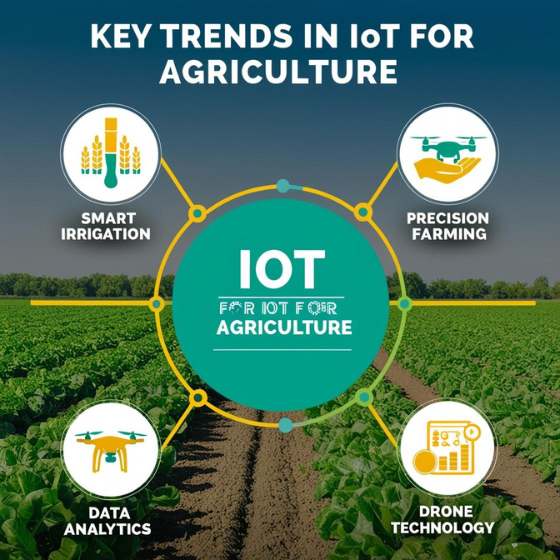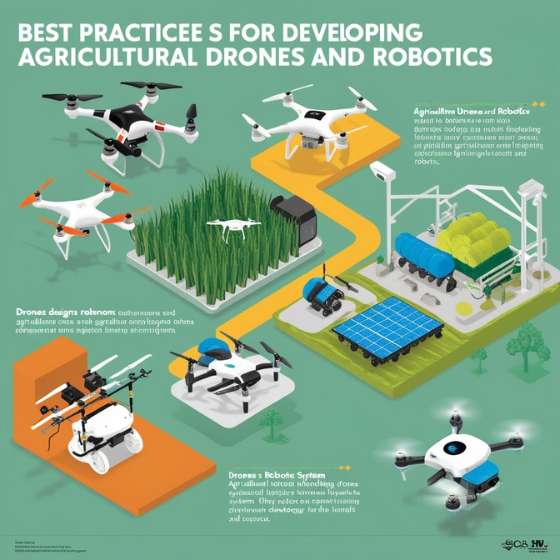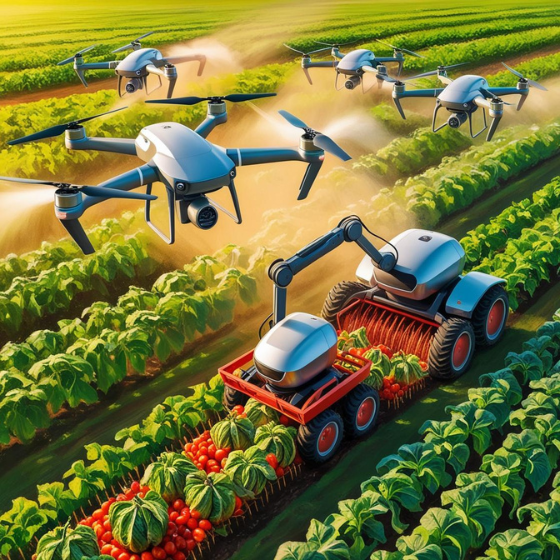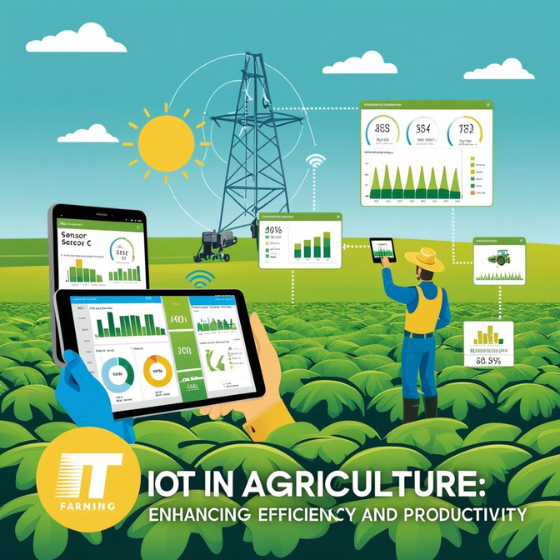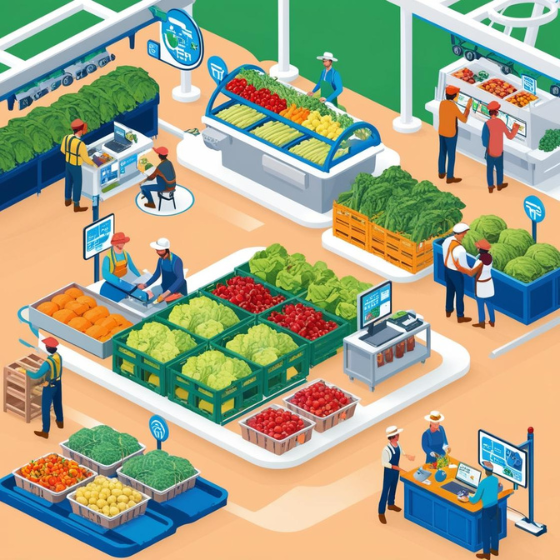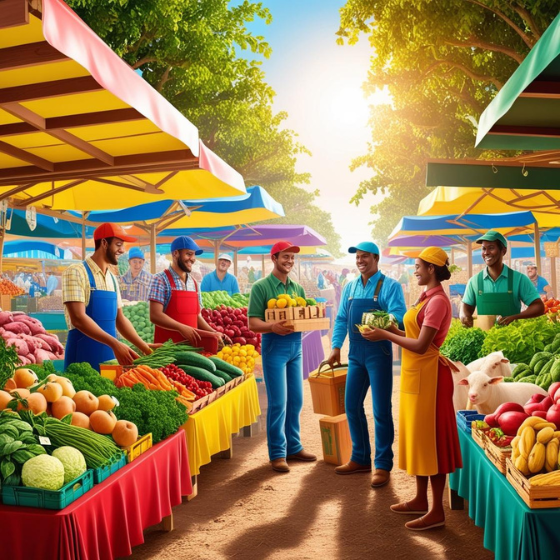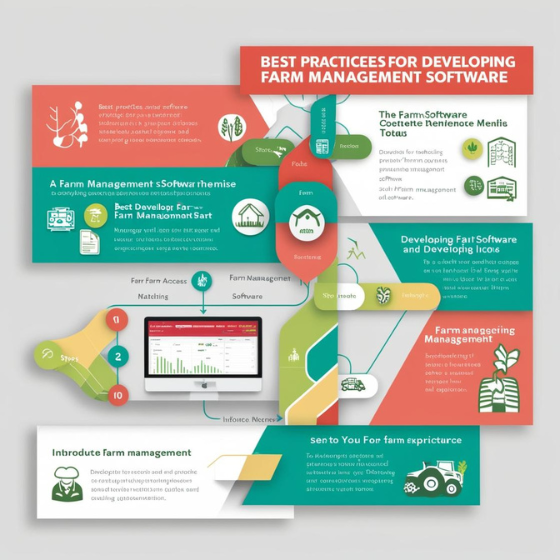Key Trends in IoT for Agriculture
The agricultural industry is experiencing a revolution, thanks to the rapid advancement of technology. Among the most transformative innovations is the Internet of Things (IoT), which is enhancing farming practices by providing real-time data, automation, and advanced analytics. IoT in agriculture is improving productivity, efficiency, and sustainability. In this blog, we will explore the key trends in IoT for agriculture and how they are shaping the future of farming.
1. Precision Agriculture: Data-Driven Farming
Precision agriculture is one of the most prominent trends in IoT for agriculture. It leverages sensors, GPS, and real-time data to monitor and manage farming operations. The goal of precision farming is to apply resources like water, fertilizers, and pesticides only where and when they are needed, leading to more efficient and sustainable practices.
- Soil Monitoring: IoT sensors can measure soil conditions such as moisture, pH, and temperature. This data enables farmers to optimize irrigation schedules and fertilization, preventing overuse of water and chemicals.
- Variable Rate Technology: With precision agriculture, farmers can apply inputs at variable rates across different areas of the field based on the unique requirements of the soil and crop conditions.
By using IoT-driven precision farming tools, farmers can enhance yields, reduce waste, and make farming more sustainable.
2. Automation and Robotics in Agriculture
IoT-powered automation and robotics are transforming how farming tasks are performed. From autonomous tractors to drones, agricultural robots are becoming more common in modern farms. These technologies help with various tasks, such as planting, harvesting, and monitoring crop health.
- Autonomous Tractors: These tractors can operate without human intervention, using IoT sensors and GPS to follow predetermined paths and perform tasks such as tilling or planting.
- Drones for Crop Surveillance: Drones equipped with IoT sensors capture high-resolution images and real-time data, providing farmers with valuable insights into crop health, pest infestations, and soil conditions.
- Robotic Harvesters: IoT-powered robotic harvesters are able to pick fruits and vegetables with precision, reducing labor costs and increasing harvest efficiency.
Automation powered by IoT technology not only reduces human labor but also ensures higher efficiency and accuracy, making farming operations more productive and cost-effective.
3. Livestock Monitoring and Health Tracking
IoT has revolutionized livestock management, offering farmers innovative ways to monitor the health and well-being of their animals. Wearable IoT devices, such as smart collars or tags, are now commonly used to collect data on livestock behavior, health, and location.
- Health Monitoring: IoT-enabled wearables can monitor vital signs such as heart rate, body temperature, and activity levels. This allows farmers to detect early signs of illness and provide timely intervention.
- Tracking Movement: GPS-enabled collars help farmers track the location of their livestock, ensuring they remain within designated grazing areas or identifying any animals that may have strayed.
- Breeding and Reproduction: IoT sensors can also monitor the reproductive health of livestock, tracking heat cycles and providing alerts for optimal breeding times.
These IoT applications enable farmers to maintain healthier livestock, improve animal welfare, and increase productivity.
4. Smart Irrigation Systems
Water scarcity is a growing concern in many parts of the world, and efficient water management is crucial for sustainable agriculture. IoT-based smart irrigation systems help farmers optimize water usage by automatically adjusting irrigation schedules based on real-time data.
- Soil Moisture Sensors: These sensors measure the moisture levels in the soil, enabling farmers to water crops only when necessary. This helps conserve water and reduce irrigation costs.
- Weather Data Integration: IoT irrigation systems can also integrate weather data to adjust watering schedules according to rainfall forecasts, ensuring that water is not wasted.
- Automated Irrigation Systems: IoT-driven irrigation systems can automatically turn on and off based on the readings from soil moisture sensors and weather forecasts, ensuring crops receive the right amount of water at the right time.
With smart irrigation, farmers can save water, improve crop yields, and reduce costs associated with water management.
5. Predictive Analytics for Crop Health
Predictive analytics, powered by IoT, is becoming a key trend in agriculture. By analyzing real-time data collected from sensors and other IoT devices, farmers can predict potential issues such as pest infestations, disease outbreaks, or nutrient deficiencies before they escalate.
- Pest and Disease Detection: IoT sensors can detect environmental conditions conducive to pests and diseases, allowing farmers to take preventive measures before damage occurs.
- Nutrient Deficiency Monitoring: Sensors can monitor soil and plant health, alerting farmers to nutrient deficiencies so they can apply fertilizers precisely where needed.
- Climate Prediction: IoT devices, when combined with weather data, can predict adverse weather events, allowing farmers to prepare and protect crops accordingly.
By leveraging predictive analytics, IoT enables farmers to address issues proactively, preventing crop damage and improving overall productivity.
6. Supply Chain Transparency and Traceability
IoT technology is transforming the agricultural supply chain by providing better transparency and traceability. IoT devices such as RFID tags and sensors can be used to track products from farm to market, ensuring that the entire supply chain is optimized and secure.
- RFID and Barcode Tracking: IoT-enabled RFID tags and barcode scanning can track agricultural products throughout the entire supply chain, from harvest to transportation and storage.
- Cold Chain Monitoring: For perishable goods, IoT sensors can monitor the temperature and humidity during transportation, ensuring that food products maintain their quality and safety.
- Supply Chain Efficiency: IoT data can be used to optimize logistics, reducing transportation costs and ensuring timely delivery.
By providing end-to-end traceability, IoT increases consumer trust and ensures that food products meet safety and quality standards.
7. Energy Efficiency and Sustainability
Energy consumption is another area where IoT is making a significant impact. With the help of IoT sensors, farmers can monitor and optimize energy usage on their farms, making operations more sustainable and cost-effective.
- Energy Usage Monitoring: IoT devices can track energy consumption across farming operations, such as irrigation systems, greenhouse climate control, and livestock management, helping to reduce energy waste.
- Renewable Energy Integration: Some farms are integrating IoT with renewable energy sources, such as solar panels or wind turbines, to power IoT devices and reduce dependence on non-renewable energy.
IoT-driven energy efficiency initiatives contribute to more sustainable farming practices, helping farmers reduce their carbon footprint and lower operational costs.
8. Blockchain Integration for Agricultural Data
Another emerging trend is the integration of blockchain technology with IoT in agriculture. Blockchain provides a secure and transparent way to store and share agricultural data, ensuring that information is tamper-proof and verifiable.
- Data Security: By using blockchain, farmers can securely store data collected by IoT devices, such as crop yield data, soil conditions, and harvest times.
- Smart Contracts: Blockchain-based smart contracts can automate transactions and agreements within the agricultural supply chain, improving efficiency and reducing the need for intermediaries.
The combination of IoT and blockchain creates a powerful solution for data integrity, transparency, and secure transactions in agriculture.
Conclusion
IoT is undoubtedly transforming the agriculture industry, offering a multitude of benefits ranging from precision farming to livestock management, improved irrigation practices, and enhanced supply chain transparency. As IoT technology continues to evolve, we can expect even more innovative solutions to emerge, enabling farmers to achieve higher productivity and sustainability. By adopting these trends and integrating IoT solutions into their operations, farmers can stay ahead of the curve and address the challenges facing modern agriculture.
If you’re interested in implementing IoT solutions to enhance your agricultural operations, Sodio offers cutting-edge technologies and expert consulting to help you make the most of IoT in agriculture. Contact us today to learn how we can assist in transforming your farm with smart technology.
